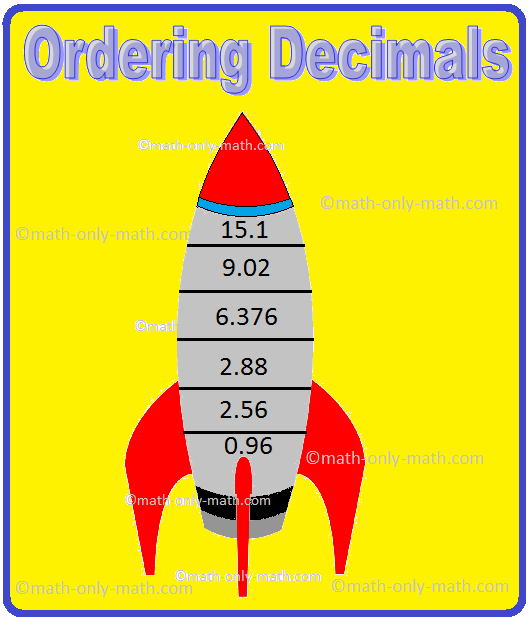Conversion of Mixed Recurring Decimals into Vulgar Fractions
Follow the steps for the conversion of mixed recurring decimals into vulgar fractions:
(i) First write the decimal form by removing the bar from the top and put it equal to x (any variable).
(ii) Now, find the number of digits having no bar after the decimal point.
(iii) Suppose there are n-digits without bar, multiply both sides by 10n, so that only the repeating decimal digit is on the right side of the decimal point.(iv) Now write the repeating digits at least twice.
(v) Now, find the number of digits having bar after the decimal point.
(vi) Suppose there are n-digits having bar, multiply both sides by 10n.(vii) Then subtract the number obtained in step (i) from the number obtained in step (ii).
(viii) Then divide both the sides of the equation by the coefficient of x.
(ix) Therefore, we get the required vulgar fraction in the lowest form.
Worked-out examples for the conversion of mixed recurring decimals into vulgar fractions:
1. Express 0.18 as vulgar fraction.Solution:
x = 0.18Multiply both sides by 10 (Since number of digits without bar is 1)
10x = 1.810x = 1.88…… ---------- (i)
10 × 10x = 1.88…… × 10 (Since number of digits having bars is 1)
100x = 18.8….. ------------- (ii)
Subtracting (i) from (ii)
100x - 10x = 18.8 - 1.8
90x = 17
x = 17/90
Therefore, the vulgar fraction = 17/90
Solution:
x = 0.23Multiply both sides by 10 (Since number of digits without bar is 1)
10x = 2.310x = 2.33…… ---------- (i)
10 × 10x = 2.33…… × 10 (Since number of digits having bars is 1)
100x = 23.3….. ------------- (ii)
Subtracting (i) from (ii)
100x - 10x = 23.3 - 2.3
90x = 21
x =x = 7/30
Therefore, the vulgar fraction = 7/30
3. Express 0.43213 as vulgar fraction.
Solution:
x = 0.43213Multiply both sides by 100 (Since number of digits without bar is 2)
100x = 43.213100x = 43.213213…… ---------- (i)
100 × 1000x = 43.213…… × 1000 (Since number of digits having bars is 3)
100000x = 43213.213….. ------------- (ii)
Subtracting (i) from (ii)
100000x - 100x = 43213.213 - 43.213213
99900x = 43170
x = 4317x = 4317/9990
Therefore, the vulgar fraction = 4317/9990
Shortcut method for solving the problems on conversion of mixed recurring decimals into vulgar fractions:
The difference between the number formed by all the digits in decimal part and the number formed by digits that are not repeated, gives the numerator of the vulgar fraction and for its denominator the number formed by as many nines as there are recurring digits which are repeated followed by as many zeros as the number of non-repeating or non-recurring digits.
For example;
Express 0.123 as vulgar fraction.Numerator = 123 - 12 = 111
Denominator = one nine (as there are one recurring digit) followed by two zeros (as there are two non-recurring digits) = 900
Required fraction = 111/900 (reduce to its simplest form)
Therefore, the vulgar fraction = 37/300
● Related Concept
● Decimals
● Conversion of Unlike Decimals to Like Decimals
● Decimal and Fractional Expansion
● Converting Decimals to Fractions
● Converting Fractions to Decimals
● H.C.F. and L.C.M. of Decimals
● Repeating or Recurring Decimal
● BODMAS/PEMDAS Rules - Involving Decimals
● PEMDAS Rules - Involving Integers
● PEMDAS Rules - Involving Decimals
● BODMAS Rules - Involving Integers
● Conversion of Pure Recurring Decimal into Vulgar Fraction
● Conversion of Mixed Recurring Decimals into Vulgar Fractions
● Rounding Decimals to the Nearest Whole Number
● Rounding Decimals to the Nearest Tenths
● Rounding Decimals to the Nearest Hundredths
● Simplify Decimals Involving Addition and Subtraction Decimals
● Multiplying Decimal by a Decimal Number
● Multiplying Decimal by a Whole Number
● Dividing Decimal by a Whole Number
● Dividing Decimal by a Decimal Number
From Conversion of Mixed Recurring Decimals into Vulgar Fractions to HOME PAGE
Didn't find what you were looking for? Or want to know more information about Math Only Math. Use this Google Search to find what you need.
Recent Articles
-
Missing Numbers up to 10 | Worksheets on Missing Numbers up to 10
Apr 18, 25 04:53 PM
Printable worksheets on missing numbers up to 10 help the kids to practice counting of the numbers. -
Ordering Decimals | Comparing Decimals | Ascending & Descending Order
Apr 18, 25 01:49 PM
In ordering decimals we will learn how to compare two or more decimals. (i) Convert each of them as like decimals. (ii) Compare these decimals just as we compare two whole numbers ignoring -
Worksheet on Comparing and Ordering Decimals |Arranging Decimals
Apr 18, 25 01:14 PM
Practice different types of math questions given in the worksheet on comparing and ordering decimals. This worksheet contains questions mainly related to compare decimals and then place the decimals i… -
Decimal Place Value Chart |Tenths Place |Hundredths Place |Thousandths
Apr 18, 25 12:58 PM
Decimal place value chart are discussed here: The first place after the decimal is got by dividing the number by 10; it is called the tenths place. -
Conversion of a Decimal Fraction into a Fractional Number | Decimals
Apr 18, 25 12:28 PM
We will discuss here about the working rule for the conversion of a decimal fraction into a fractional number. The rules of converting decimal number to fraction are





New! Comments
Have your say about what you just read! Leave me a comment in the box below. Ask a Question or Answer a Question.